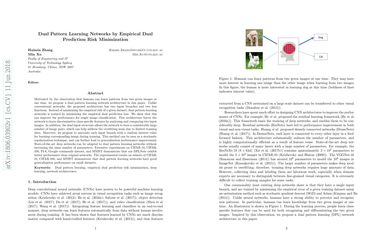Dual Pattern Learning Networks by Empirical Dual Prediction Risk Minimization
Motivated by the observation that humans can learn patterns from two given images at one time, we propose a dual pattern learning network architecture in this paper. Unlike conventional networks, the proposed architecture has two input branches and two loss functions. Instead of minimizing the empirical risk of a given dataset, dual pattern learning networks is trained by minimizing the empirical dual prediction loss. We show that this can improve the performance for single image classification. This architecture forces the network to learn discriminative class-specific features by analyzing and comparing two input images. In addition, the dual input structure allows the network to have a considerably large number of image pairs, which can help address the overfitting issue due to limited training data. Moreover, we propose to associate each input branch with a random interest value for learning corresponding image during training. This method can be seen as a stochastic regularization technique, and can further lead to generalization performance improvement. State-of-the-art deep networks can be adapted to dual pattern learning networks without increasing the same number of parameters. Extensive experiments on CIFAR-10, CIFAR- 100, FI-8, Google commands dataset, and MNIST demonstrate that our DPLNets exhibit better performance than original networks. The experimental results on subsets of CIFAR- 10, CIFAR-100, and MNIST demonstrate that dual pattern learning networks have good generalization performance on small datasets.
PDF Abstract

 CIFAR-10
CIFAR-10
 CIFAR-100
CIFAR-100
 MNIST
MNIST